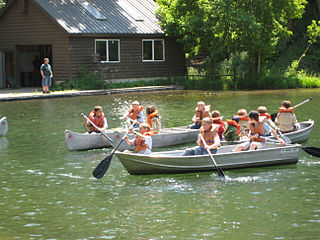
Scouting in Utah has a long history, from the 1910s to the present day, serving thousands of youth in programs that suit the environment in which they live.

Lehi is a city in Utah County, Utah, United States. It is named after Lehi, a prophet in the Book of Mormon. The population was 75,907 at the 2020 census, up from 47,407 in 2010. The rapid growth in Lehi is due, in part, to the rapid development of the tech industry region known as Silicon Slopes. The center of population of Utah is located in Lehi.

Utah State University is a public land-grant research university in Logan, Utah. It is accredited by the Northwest Commission on Colleges and Universities. With nearly 20,000 students living on or near campus, USU is Utah's largest public residential campus. As of Fall 2021, there were 27,426 students enrolled, including 24,255 undergraduate students and 3,171 graduate students. The university has the highest percentage of out-of-state students of any public university in Utah, totaling 23% of the student body.
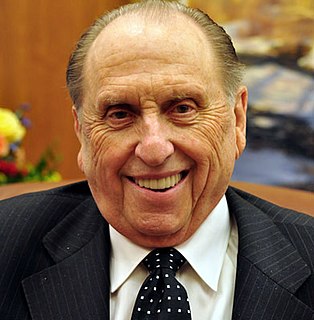
Thomas Spencer Monson was an American religious leader, author, and the 16th President of The Church of Jesus Christ of Latter-day Saints. As president, he was considered by adherents of the religion to be a prophet, seer, and revelator. Monson's early career was as a manager at the Deseret News, a Utah newspaper owned by the LDS Church. He spent most of his life engaged in various church leadership positions and public service.

KSL-TV is a television station in Salt Lake City, Utah, United States, affiliated with NBC. It is the flagship television property of locally based Bonneville International, the for-profit broadcasting arm of The Church of Jesus Christ of Latter-day Saints, and is sister to KSL radio. The three stations share studios at the Broadcast House building in Salt Lake City's Triad Center; KSL-TV's transmitter is located on Farnsworth Peak in the Oquirrh Mountains, southwest of Salt Lake City. The station has a large network of broadcast translators that extend its over-the-air coverage throughout Utah, as well as portions of Arizona, Idaho, Nevada and Wyoming.
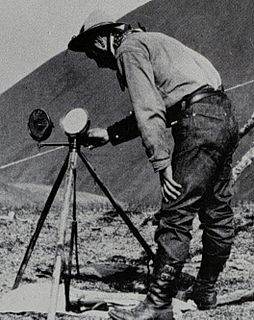
A heliograph is a semaphore system that signals by flashes of sunlight reflected by a mirror. The flashes are produced by momentarily pivoting the mirror, or by interrupting the beam with a shutter. The heliograph was a simple but effective instrument for instantaneous optical communication over long distances during the late 19th and early 20th century. Its main uses were military, survey and forest protection work. Heliographs were standard issue in the British and Australian armies until the 1960s, and were used by the Pakistani army as late as 1975.

KSL Newsradio is a pair of radio stations serving the Salt Lake City, Utah region, consisting of the original AM station, KSL, licensed to Salt Lake City on 1160 kHz, and FM station KSL-FM, licensed to Midvale on 102.7 MHz. Owned by Bonneville International, a broadcasting subsidiary of The Church of Jesus Christ of Latter-day Saints, the stations share studios with sister television station KSL-TV in the Broadcast House building at the Triad Center in downtown Salt Lake City.

Varsity Scouting was a program of the BSA. It was an alternative available to boys ages fourteen to eighteen until the end of 2017. It used the basic Boy Scouting program and added high adventure, sporting, and other elements that were more appealing to older youth to accomplish the aims of character development, citizenship training, and personal fitness. Varsity Scouts were organized into teams; separate chartered units from a Boy Scout troop.
KJZZ-TV is an independent television station in Salt Lake City, Utah, United States. It is owned by Sinclair Broadcast Group alongside CBS affiliate KUTV and MyNetworkTV affiliate KMYU in St. George. The stations share studios on South Main Street in downtown Salt Lake City, while KJZZ-TV's transmitter is located on Farnsworth Peak in the Oquirrh Mountains, southwest of Salt Lake City. KJZZ-TV is the ATSC 3.0 host station for the Salt Lake City market; in turn, other stations broadcast its subchannels on its behalf.
Peaks Ice Arena is an indoor ice hockey and figure skating arena in Provo, Utah, located 43 miles (69 km) south of Salt Lake City. Along with the Maverik Center in West Valley City, it was built as an ice hockey and figure skating practice venue for the 2002 Winter Olympics. It currently serves as the home of the BYU Cougars men's ice hockey team, Peaks Youth Hockey Association, several high school teams, the Peaks Figure Skating Club, and a Learn-to-Skate USA program for beginning skaters of all ages.
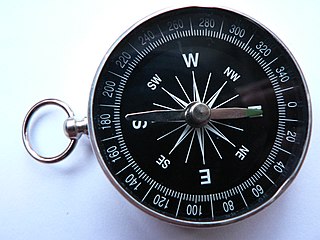
The Ten Essentials are survival items that hiking and Scouting organizations recommend for safe travel in the backcountry.
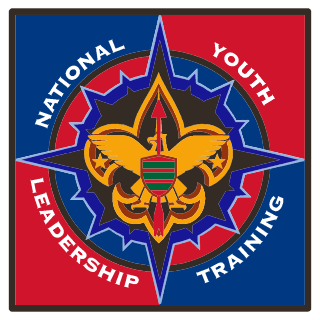
National Youth Leadership Training, often called NYLT, is the current youth leadership development training offered by the Boy Scouts of America. The program is conducted at the council level over six days for Scouts, Venturers, and Sea Scouts. The program has been open to all genders since 2010. This training is a part of the national organization's leadership training program and is designed to mirror themes found in Woodbadge, which is the BSA program for adult leadership training.

KTMW is a television station in Salt Lake City, Utah, United States, broadcasting the Spanish-language Telemundo network to the state of Utah. Owned and operated by NBCUniversal's Telemundo Station Group, the station maintains studios are located on South Redwood Road in the northwestern section of Salt Lake City, and its transmitter is located on Farnsworth Peak in the Oquirrh Mountains, southwest of Salt Lake City.

Anthony Joseph Knap was an American football coach. He was the head coach at Utah State University (1963–1966), Boise State University (1968–1975), and the University of Nevada, Las Vegas (1976–1981). He compiled a career college football record of 143–53–4 (.725). Knap also worked as a high school teacher and coach, and served in the U.S. Navy during World War II.

Kanosh was a nineteenth-century leader of the Pahvant band of the Ute Indians of what is now central Utah having succeeded the more belligerent Chuick as principal chief. His band had "a major camp at Corn Creek." He is remembered for having been "friendly toward early Mormon Pioneer settlers."

Farnsworth Peak is a peak located on the northern end of the Oquirrh Mountain range, approximately 18 miles (29 km) south west of Salt Lake City, Utah, United States. The mountain is named for Philo Farnsworth, the inventor of the first completely electronic television. It is used mainly for radio and television transmission, but could potentially become part of a ski resort owned by nearby Kennecott Land. On the eastern side of the mountain, the land is completely private, and access is restricted. The peak can be reached by hiking from the Tooele side, which is mostly public land. The Bureau of Land Management land extends from Ridge Peak west to the base of the mountain. Public access to this land is available off SR-36 near Lake Point. Several cattle gates need to be opened and closed, but are access roads to hiking, mountain biking, and horseback riding areas.
Rosemary Mix Wixom was the general president of the Primary of The Church of Jesus Christ of Latter-day Saints from 2010 to 2016. She was the twelfth general president of the Primary, the organization that is responsible for the instruction of the church's children ages three to eleven.
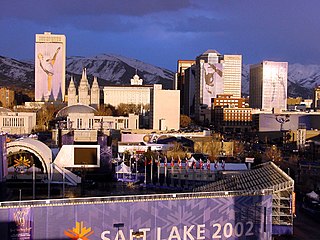
The 2002 Winter Olympic Games were held in and around Salt Lake City, United States from February 8 to 24, 2002, and the Paralympics from March 7 to 16, 2002. The sporting events were held in ten competitive venues, while non-competitive events, such as the opening ceremony, were held in six other venues. Three venues were also created for training purposes. All Olympic venues were scattered throughout Northern Utah.
Cherry Peak is a ski area in northern Utah that opened in 2014 and first used for skiing in the 2015–2016 season. It is located in Cherry Canyon, east of Richmond, Utah in the Bear River Mountains. While smaller and less developed than a number of Utah ski resorts, Cherry Peak is close and convenient to residents of nearby Logan, Utah State University, and Cache Valley. It also hosts students from more distant universities.

The 1921 Idaho Vandals football team represented the University of Idaho in the 1921 college football season. Idaho was led by second-year head coach Thomas Kelley in their last season as an independent before joining the Pacific Coast Conference. The Vandals had two home games in Moscow, one on campus at MacLean Field and another at the fairgrounds; they also played one in Boise at Public School Field.


















